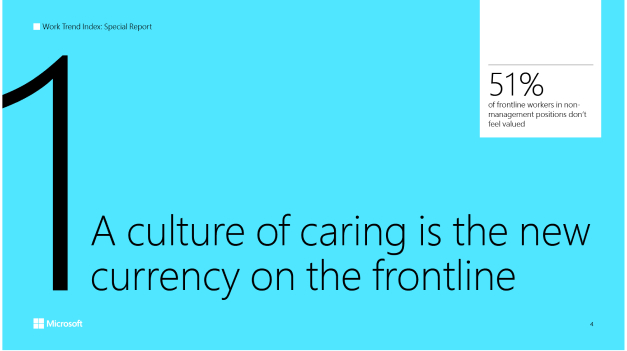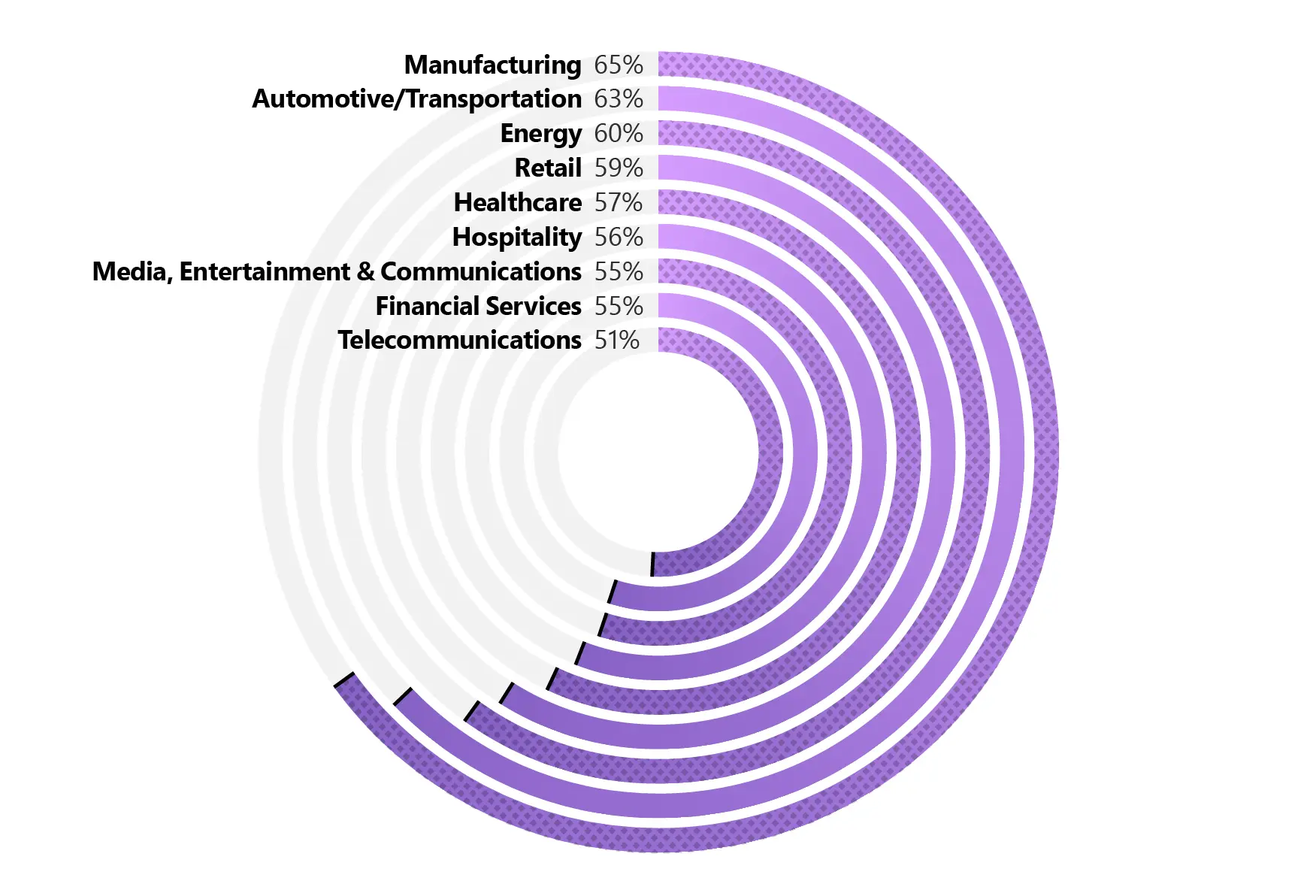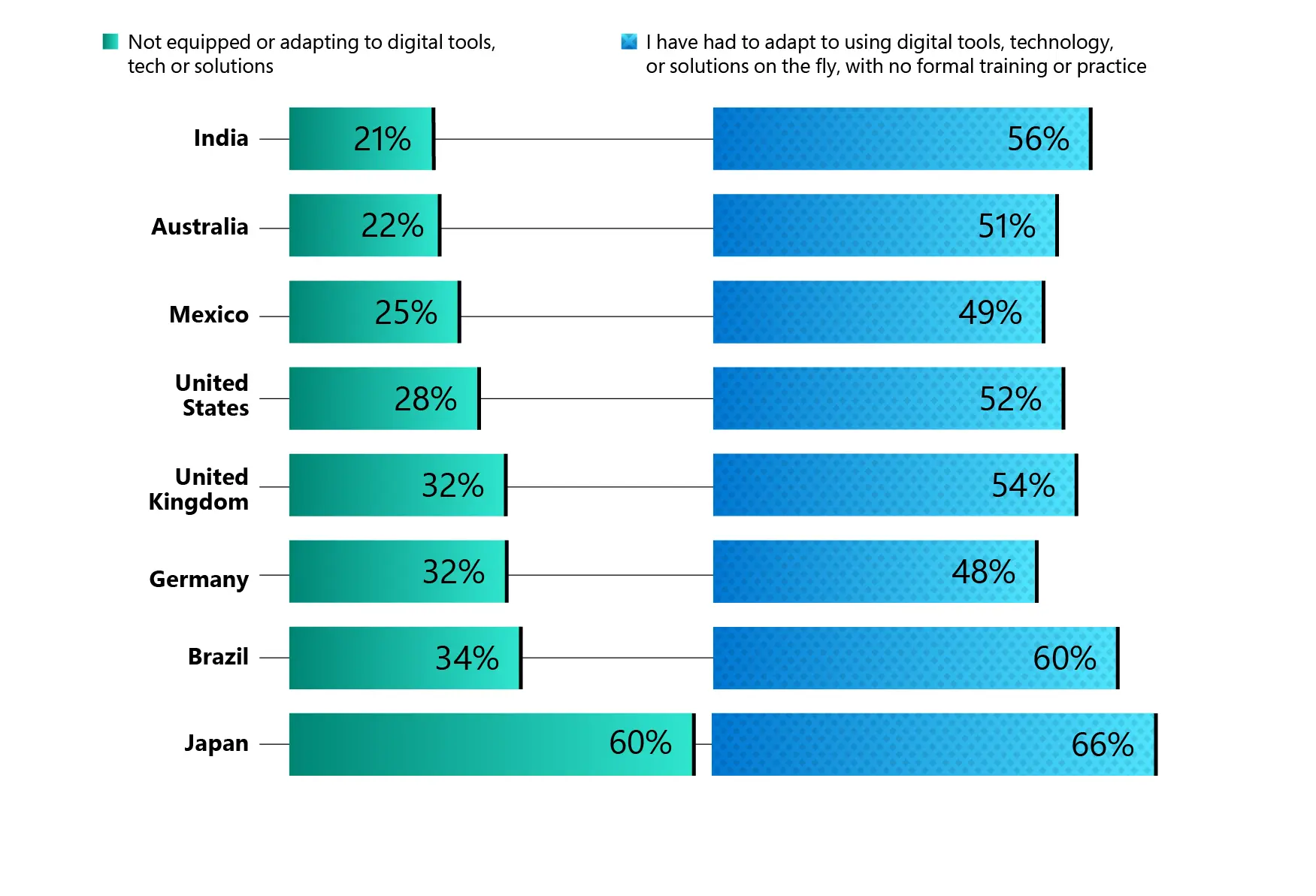
Over the past two years , in order to inform the ways in which our technology solutions can better support our customers’ needs, Microsoft has continued to study how work is changing. Now, as we look ahead to 2022, we’re doing a deep dive on a segment of the workforce that never went home to work—the frontline.
Representing 80 percent of the global workforce , no one has borne the burden of the past two years more than the 2 billion frontline workers around the globe. They’ve kept grocery stores stocked, ensured the power grid stayed up and running, provided essential healthcare services, and made and distributed the products the world depends on—all while weathering personal risk and ongoing disruption. And as the world continues to endure economic and pandemic uncertainty, many businesses face the near-impossible challenge of keeping the doors open while ensuring the wellbeing of employees.
Despite their essential role in every industry, these workers have traditionally been underserved by technology. Just as the pandemic was a catalyst for spurring rapid digital transformation for information workers, the data suggests we’re at a similar inflection point on the frontline.
This Special Report—part of our ongoing Work Trend Index —explores findings from a survey of 9,600 frontline employees and managers in eight industries across five continents. The data helps shed light on the challenges impacting nearly every business right now, and while technology is not the only solution, the report also reveals an opportunity for digital tools to help ease the burden on these essential workers.
Download the full report

Technology Can Help Unlock a New Future for Frontline Workers
Key Findings
A culture of caring is the new currency on the frontline: Seventy-six percent of workers feel bonded to each other, yet over 60 percent say their company could do more to prioritize culture and communication from the top. In addition, 51 percent of those in non-management positions on the frontline don’t feel valued as employees.
Frontline workers are at an inflection point: Amid the Great Reshuffle, frontline workers cite better pay and benefits, work-life balance, and flexibility as reasons for considering a job change.
Optimism for tech is high: Sixty-three percent of frontline workers are excited about the job opportunities technology creates, and technology ranks third on the list of factors that workers say could help reduce workplace stress.
There’s an opportunity to bridge the tech and training gap: Forty-six percent of frontline workers feel pressure to adapt to new technology over fear of losing their jobs—and 55 percent say they’ve had to learn new tech on the fly, with no formal training or practice.
“The pandemic has put incredible strain on frontline workers,” says Jared Spataro, corporate vice president of Modern Work at Microsoft. “But across all of our research, we are getting a clear signal about the opportunity to align business outcomes with the wellbeing and growth of employees. And it’s encouraging to see that technology can help.”
1.
A culture of caring is the new currency on the frontline
62%
of all frontline workers say leadership does not prioritize building culture
58%
of frontline workers believe that work stress will either stay the same or worsen in the coming year
Microsoft Chairman and CEO Satya Nadella talks about the importance of strengthening the connections between employees, a company’s mission, and their managers. Our research shows that the pandemic has strengthened some of these ties, while fraying others.
To weather the storm, frontline workers have turned to each other. Seventy-six percent report that they “feel very bonded to co-workers” because of shared stresses brought on by the pandemic. But their connections to leadership and company culture are weak. Sixty-two percent of all frontline workers say that leadership does not prioritize building workplace culture—and that jumps to 68 percent for those in management positions on the frontline such as department heads, store managers, and shop-floor supervisors.
Furthermore, communication isn’t trickling down—or bubbling up. Sixty-three percent of all frontline workers say messages from leadership don’t make it to them. Things are especially trying for frontline managers (69 percent) who say their higher-ups are not effectively communicating with them either. At the same time, 32 percent of frontline workers feel their voice is not being heard when communicating workplace issues.
Workers see a culture and communication gap
While frontline workers say they feel more bonded to one another, most say culture and communication need to be better prioritized from the top

This Work Trend Index Special Report survey was conducted by an independent research firm, Edelman Data x Intelligence, among 9,600 full-time or part-time employed frontline workers across eight (8) industries and eight (8) markets, between October 28 and November 19, 2021. A total of 1,200 frontline workers were surveyed within each industry.
Choosing the right communication platform can strengthen workplace connections. For example, Blum , a family-run furniture fitting company, once relied on supervisors and a factory floor notice board to share updates with employees. Today, Blum uses the employee experience platform Microsoft Viva to centralize company news, tasks, and conversations, giving frontline workers a consistent connection to the larger company that they can access from anywhere. “This isn’t just about one-way communication,” says Sarah Blum, employer branding and recruiting specialist at Blum. “We can have direct conversations with employees and answer their questions, and they feel heard.”
And as companies balance pandemic realities with employee needs, the research shows an opportunity to focus more on the wellbeing of frontline workers. Fifty-one percent of frontline workers in non-management positions don’t feel valued as employees, and many workers (60 percent) wish more was being done to help with physical exhaustion or to support mental health (57 percent).
Those on the frontline are feeling the pressure of external challenges, too. Most workers surveyed feel more could be done to help supply chain issues (52 percent), and say that labor shortages are making their jobs especially difficult (51 percent).
And as we embark on year three of the pandemic, 58 percent of frontline workers around the world believe that work stress will either stay the same or worsen in the coming year. In addition to economic challenges, frontline workers globally cite workload (45 percent), low wages (44 percent), long workdays (41 percent), managing needs of customers (35 percent), and COVID-19 protocols (33 percent) as the top five reasons for their work-related stress.
“The pandemic has created an extraordinary strain on the individuals on the frontlines,” says Dr. David Rhew, global chief medical officer for Microsoft, whose own frontline experience informs Microsoft’s healthcare offerings. “Beyond the very real effects of COVID on peoples’ lives and livelihoods, there’s the baseline administrative burden they have to handle, and then the workforce is diminishing so there’s more and more work being placed on top of them. It’s just created an extraordinary amount of pressure and stress.”
Workers anticipate increasing stress
Frontline employees in Japan, the UK, and Germany—as well as those in the manufacturing, auto/transportation, and energy industries—are most concerned that stress at work will stay the same or get worse in the year ahead

This Work Trend Index Special Report survey was conducted by an independent research firm, Edelman Data x Intelligence, among 9,600 full-time or part-time employed frontline workers across eight (8) industries and eight (8) markets, between October 28 and November 19, 2021. A total of 1,200 frontline workers were surveyed within each industry.
2.
Frontline workers are at an inflection point
4.5M
Americans quit their jobs in November
With the pandemic enduring, stress levels high, and a record 4.5 million Americans quitting their jobs in November , it’s clear workers are at an inflection point. In our survey, frontline workers globally cited the following top five reasons for considering a job change: to make more money, to have a better work-life balance, not receiving pay increases, working for a company with better benefits, and looking for more flexibility in how they work.
And as mentioned, when it comes to frontline managers—the glue between corporate and the frontline—the data suggests they are especially feeling the strain of bridging the culture and communications gap.
Data from LinkedIn also suggests people who are quitting their jobs aren’t leaving work altogether—they’re seeking new experiences. According to LinkedIn hiring data, seven out of the eight industries examined in this report have now exceeded pre-pandemic hiring levels, and all except retail have experienced double-digit year-over-year growth.
As more frontline workers rethink the role that work plays in their lives and engage in the Great Reshuffle, organizations have a massive opportunity to create an operating model and culture that attracts the best managers and employees to their ranks.
3.
Optimism for tech is high
63%
of frontline workers are excited about the job opportunities tech creates
46%
of frontline workers say they even value tech tools over mental health and wellness benefits
For years, many frontline workers have been concerned that technology―especially automation and AI―would make their jobs obsolete.
“I come across a lot of people who are worried about being replaced by artificial intelligence, by machine learning,” says Darryl Willis, Microsoft’s corporate vice president of the energy and sustainability industry. “One of the things I say to people is that you have to see machine learning and AI as an assistant, not a replacement, for expertise.”
That idea is slowly taking hold. According to our research, 63 percent of frontline workers are excited about the job opportunities that technology creates. The aspects of work with which they believe it can help “a lot” include team scheduling, onboarding new teammates, automating repetitive tasks, providing real-time task updates, and managing appointments.
Tech also ranks high on the list of factors that could help reduce work-related stress, just behind better pay and vacation time. And 46 percent of respondents say they even value technological tools over mental health support and wellness benefits.
What can reduce stress on the frontline?
Better tech ranks third on a list of things frontline workers say could reduce stress, just behind better pay and vacation time

This Work Trend Index Special Report survey was conducted by an independent research firm, Edelman Data x Intelligence, among 9,600 full-time or part-time employed frontline workers across eight (8) industries and eight (8) markets, between October 28 and November 19, 2021. A total of 1,200 frontline workers were surveyed within each industry.
Across industries, tech is already helping frontline workers navigate a rapidly changing landscape of work. Among frontline workers, there has been a 400 percent spike in monthly Microsoft Teams usage from March 2020 to November 2021.
Healthcare workers are booking virtual visits and using Teams’ built-in pager system to reach nurses and doctors quickly. Retail and finance workers have turned to the Shifts app in Teams to manage schedules. And manufacturing and automotive workers are using tools like the Teams-powered walkie-talkie and Teams-connected mixed reality headsets to connect to corporate and troubleshoot issues on the factory floor.
For instance, Chevron employees are using Microsoft HoloLens mixed reality headsets and hard hats equipped with Teams to troubleshoot issues and connect with experts for inspections. In often loud environments, employees can directly share what they see and hear via mixed reality, instead of trying to describe the situation verbally. Retailer Canadian Tire is also using Teams to streamline the curbside pickup process.
Technology adoption on the frontline is accelerating
Between March 2020 and November 2021, the monthly use of Microsoft Teams on the frontline grew by 400 percent in the aggregate, with the most growth seen in healthcare, financial services, and media and communications

4.
There’s an opportunity to bridge the tech-equity and training gap
55%
of frontline workers have had to adapt to using digital tools on the fly, with no formal training or practice
There is still more that can be done to help ensure frontline workers are as well-equipped as workers who sit behind a desk. One-third of all frontline workers say they do not have the right technological tools to do their job effectively; that number rises to 41 percent for those in non-management positions.
“Frontline workers are the face of your business,” says Kristina Behr, Microsoft’s vice president of product management for frontline workers and industry. “Making sure that they are empowered and equipped with the optimal tools is vitally important for success. If it’s frustrating for you to use the tools, your whole job is frustrating.”
Access to―and training for―technology that automates tasks, provides remote assistance, and helps workers communicate with each other varies widely among frontline workers. Our research shows that healthcare, hospitality, telecommunications, and automotive/transportation have all lagged in training employees prior to implementing the latest digital tools. Frontline workers in Japan, Brazil, India, and the UK are similarly behind the pack.
Workers see a tech and training gap
Employees in some industries and countries are lacking the tech and training they need to do their jobs effectively

This Work Trend Index Special Report survey was conducted by an independent research firm, Edelman Data x Intelligence, among 9,600 full-time or part-time employed frontline workers across eight (8) industries and eight (8) markets, between October 28 and November 19, 2021. A total of 1,200 frontline workers were surveyed within each industry.
For many, falling behind has become a major concern. Nearly half (46 percent) of frontline workers worry that they could lose their jobs if they don’t adapt to new tech.
Our research shows that older workers—age 41 and up—struggle with adapting to new technology. But younger workers (40 and under) also feel frustration from inadequate tools. “The average hourly worker in a store now is a digital native who came into their first job with a smartphone in their hand,” says Shelley Bransten, Microsoft’s corporate vice president of retail & consumer goods. “So they’re expecting the experience they have at work to match up with their experience outside of work, and that divide has not been crossed yet.”
Even among those workers who do receive the latest digital tools, many of them haven’t been properly trained in how to use them: 55 percent have had to adapt to using digital tools on the fly.
Investments in educating workers to make the best use of technology are ultimately as important as investments in the tech itself. Case in point: While Eaton, a multinational power management company, has been serving customers since 1911, it takes a decidedly modern approach to training. Using a mixed reality application for Microsoft HoloLens 2, they train employees to conduct preventive maintenance on 1,500 pieces of equipment. “The matrix hologram appears in front of you. It asks, ‘Javier, do you want to start with the welder?’ I stare at the word ‘Yes’ to confirm. You continue until you finish the checklist,” says Javier Gomez, a plant manager for Eaton. “The process takes five to seven minutes. It’s efficient and you don’t need anybody to show you what you’re looking for or what it looks like. It’s amazing.”
46%
of frontline workers worry that they could lose their jobs if they don’t adapt to new technology
5.
Recommendations
The pandemic and current economic realities are putting immense pressure on businesses of all sizes. But with projected attrition rates high and morale low, the data suggests an opportunity to focus more squarely on supporting the frontline. Based on the research, these are three areas where companies can focus first to address the issues.
Rebuild culture on the frontlines
Workplace culture is built upon a strong connection to company mission and purpose, transparency, strong lines of communication, recognition of great work, and positive workplace relationships. Our data shows that many frontline workers have built foundational relationships with each other, but more can be done to foster connection and culture from the top, especially for managers.
Leaders should make time to connect with frontline workers and managers—proactively seeking to understand their experiences, share appreciation of their efforts, spell out the company’s mission and purpose, and explain how frontline workers are contributing to it. Companies should not only establish a steady stream of company communications, but also create avenues for two-way communication so frontline workers are empowered with the information they need to both succeed and feel like they are being heard. Microsoft is focused on supporting frontline workers with tech like Microsoft Viva Connections, which can play a critical role in bridging the culture and communication gap—thereby allowing employees to access information and resources, and allowing leaders to share messages, company updates, and kudos to create a consistent sense of culture that is digestible for all workers.
Empower frontline workers with the latest tech
From team scheduling and onboarding to automating tasks and managing appointments, companies can ease daily burdens by providing the right tech tools. Microsoft is committed to making these experiences more seamless for frontline workers with custom industry-cloud solutions, as well as innovations in Teams that reduce the friction in approvals, shift scheduling, and virtual appointments. Teams-connected mixed reality headsets and hardhats, and digital walkie-talkies and pager systems make communication more seamless as well.
Empowering frontline workers with the right technology not only makes their jobs easier but it enables secure communication between customers, each other, and corporate. It allows employees to concentrate on what matters most, whether that’s the customer or the essential task at hand.
Prioritize and modernize training
Frontline workers are eager to get the training they need to adopt new technologies that will help them do their best work. But with finite resources and competing demands, they need leaders to prioritize and make space for learning at scale. At Microsoft, we want to help every organization provide equitable and accessible training to every worker. With Microsoft Viva Learning, we aim to empower frontline workers to upskill and learn right in the flow of work.
Download the full report

Technology Can Help Unlock a New Future for Frontline Workers
What Microsoft is doing to help
We hope that in releasing this research, we are helping our customers navigate this era and shedding light on the opportunities we all have to empower these essential workers. We will also continue to develop technology solutions to empower the frontline, including new updates in Microsoft Teams, Viva , and the Microsoft Industry Clouds .
Survey Methodology
This Work Trend Index Special Report survey was conducted by an independent research firm, Edelman Data x Intelligence, among 9,600 full-time or part-time employed frontline workers across eight (8) industries and eight (8) markets, between October 28 and November 19, 2021. A total of 1,200 frontline workers were surveyed within each industry. Frontline workers were defined as those that were required to work in-person or on-site in a physical space, and do not perform any work remotely. The survey was 20 minutes in length and conducted online, in either the English language or translated into a local language across markets. Global results have been aggregated across all responses to provide an average. Each market and industry has been evenly weighted within the global average. Industries surveyed include: automotive/transportation, communications (comprising media/entertainment and telecommunications sub-sectors), energy, retail, financial services, healthcare, hospitality, and manufacturing. Markets surveyed include: Australia, Brazil, Germany, India, Japan, Mexico, the United Kingdom, and the United States.
Frontline managers are defined as those who are mid-level management or higher and have at least some influence on decision making related to hiring and onboarding, business development, employee benefits, budget decisions, business operations, internal communications, use of technology or digital tools, or financial/budget decisions.

